In this issue:
Cabbage Aphid
Squash Bug
Powdery Mildew
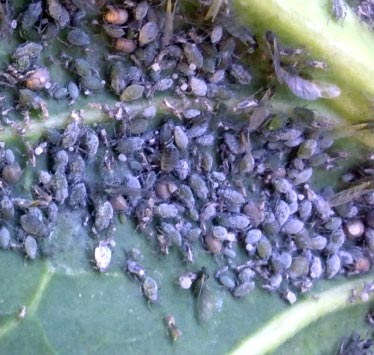 |
| Cabbage aphids, Brevicoryne brassicae |
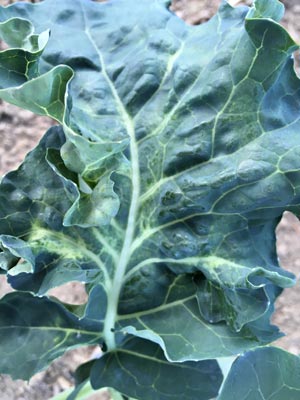 |
| Yellowing on a brassica leaf caused by cabbage aphids |
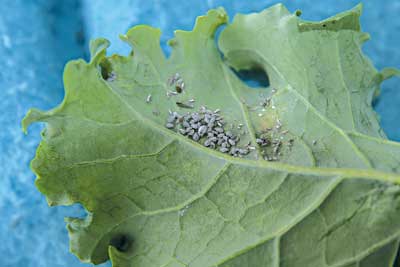 |
| Another view of cabbage aphids on the underside of a brassica leaf |
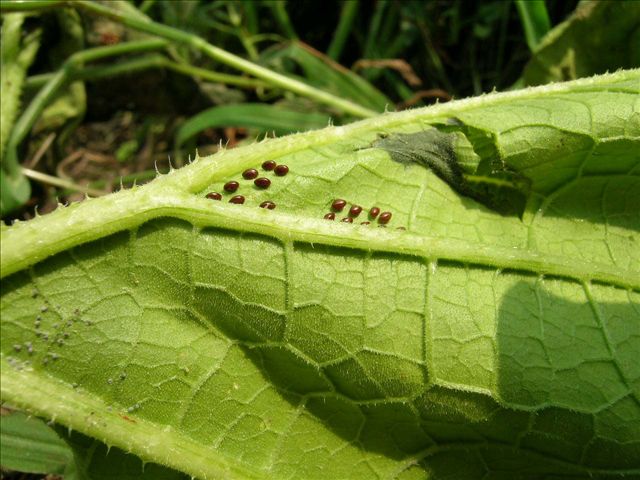 |
| Squash bug eggs |
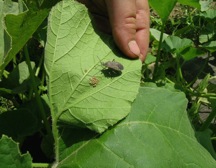 |
| Squash bug adult and eggs |
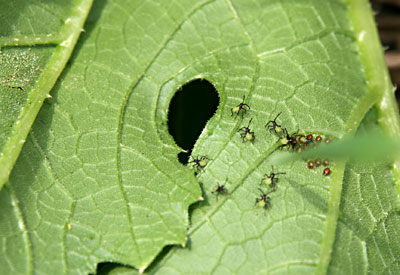 |
| Squash bug hatch |
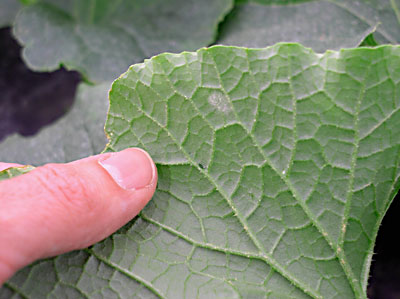 |
| First signs of powdery mildew |
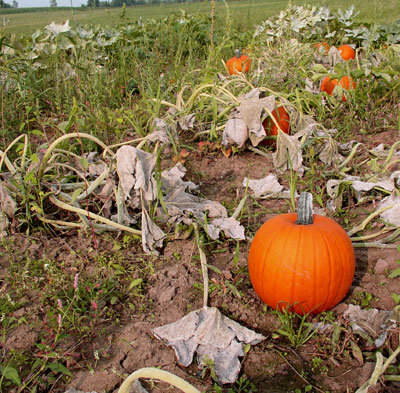 |
| Effects of powdery mildew late in the season |
CABBAGE APHID – START SCOUTING NOW!
By Becky Sideman
Those who grow crops in the Brassica family are likely familiar with the cabbage aphid, Brevicoryne brassicae, sometimes referred to by growers as “gray aphid”. It is often a significant problem on fall brassica crops, especially Brussels sprout, kale, and broccoli. In recent years, many growers in northern New England have reported increasing crop losses caused by this pest, mostly on late fall brassicas. The earliest aphids are usually found in early summer; we have already observed the first cabbage aphids on young broccoli and cabbage plants in southern NH this year.
Cabbage aphids have a distinctive whitish-gray appearance because they are covered with a white powdery wax coating. They are often found in thick clumps or colonies, feeding on the youngest tissue of Brussels sprouts, cabbage, broccoli, kale, and other members of the cabbage family.
Cabbage aphids overwinter as eggs laid on Brassica crops and weeds in the fall. The eggs hatch in early spring, giving rise to females that feed and produce live offspring. Winged aphids form after the initial infestations, and then fly to colonize new crops. In warmer climates, adults overwinter without producing eggs. It is possible that adults can overwinter in unheated high tunnels containing brassica crops here in the north. Some key cultural practices to manage cabbage aphid populations include destroying and burying brassica crop and weed residue in order to bury the eggs, managing brassica weeds (mustards, etc.), and rotating brassica crops away from where cabbage aphids were previously found.
Cabbage aphids are difficult to control if detected late in the season when populations are already very high. (It is also difficult to get insecticides to penetrate their thick colonies and into the crevices where they hide within the plant). Scout early and often, so that you know when they arrive. While the aphids themselves can be difficult to see, especially in small numbers, they produce a visible yellowing on the leaves. When you see this symptom as you walk the field, it is a good idea to examine plants more closely. Young broccoli showing characteristic yellowing where cabbage aphids have been feeding.
When there are only a couple of infested plants, you can rogue or remove those plants, or possibly even mechanically destroy the initial aphids. Because the winged aphids are distributed randomly, it is important to scout thoroughly on a weekly basis. Economic thresholds suggest that you should treat if at least 10% of the plants are infested. You can also follow this UC Davis sequential sampling procedure, to reduce time spent scouting. Colleagues at UMass created a helpful Brassica scouting sheet, which helps you record the presence of all major brassica pests in one place.
Recent research by the UMass Extension Vegetable Program and at the NH Agricultural Experiment Station have shown that decent control of cabbage aphid using organically approved insecticides is possible, but that it requires a regular scouting regime and repeated applications (we have used up to 7-8 applications per season), increasing in frequency later in the season as aphid populations climb. There are also many conventional options, but timely application and rotation between insecticide options is key. In all cases, getting good coverage and use of appropriate spreader stickers (following label recommendations) is critical.
For additional information about this pest, see the following useful resources:
University of California Pest Management Guidelines for Cabbage Aphid
Cabbage Aphid – within the New England Vegetable Management Guide
Top
SQUASH BUG
Squash bugs are serious pests of pumpkins and squash throughout North America. Damage and survival are low on watermelon, very low on cucumber and muskmelon, and highest on squash and pumpkin. Both adults and nymphs feed by inserting their beak and sucking juices from plant tissue. Toxic saliva injected during feeding causes foliage to wilt, then leaves turn black and die; the severity of this damage is directly related to density of squash bugs on each plant. Often I get calls from growers with squash bug problems who believe they have a disease. Later in the season, squash bugs may feed on the fruit, causing them to collapse or become unmarketable.
Adults are 0.5 to 0.75 of an inch long, flattened and grayish-brown. They hibernate in trash in and around the garden for the winter and emerge in the early summer to feed a bit and lay eggs. Eggs are laid in clusters usually on the underside of leaves and are orange when first laid, but turn bronze-colored before they hatch. The wingless nymphs are similar in appearance to adults, and are whitish when small, with a brown head, and grayish white when larger with black legs. There is one generation per year in the Northeast.
Black plastic, weed barrier fabric, straw mulch, and reduced tillage systems encourage higher populations, probably by providing good hiding places. Squash bug numbers are reduced by clean cultivation in the fall, and crop rotation. Infestation is delayed by row covers. If possible, rotate cucurbit crops between fields as far apart as possible. Keep headlands mowed and free of trash to reduce overwintering sites.
Squash bugs are unusually difficult to control with insecticides. Scout undersides of leaves for squash bug adults and eggs. Crush the eggs. You may not want to crush the bugs as they stink when you do.
If you miss some eggs and have to spray, time squash bug sprays to kill young nymphs just after hatch, because this stage is the easiest to control. Treat late in the day when the flowers are closed to reduce risk to bees. Neem products have proved effective.
For adult bug control, insecticides applied to the base of the plant are most effective, possibly because bugs tend to cluster. But, squash bugs are virtually impossible to control later in the season when nymphs are large and the canopy is dense.
(Source material from New England Vegetable Management Guide; Handbook of Vegetable Pests, A Capinera; ATTRA. And UMass Extension article by Andy Cavanagh & R Hazzard)
POWDERY MILDEW
Powdery mildew is a common disease of pumpkins and winter squash. All cucurbits are susceptible, but many common cucumber and melon varieties are resistant. The disease can cause infected leaves to die prematurely, reducing yields and lowering fruit quality, especially taste. Winter squash from diseased plants won’t store as long as fruits from healthy plants. The fungus that causes the disease does not overwinter in Maine. Spores blow up every year from southern overwintering sites. If they arrive late in the season, you may not need any control; but if they arrive in early to midsummer, exercise some control or you may have no leaves by mid-August, or bland starchy squash.
I have not seen any yet. Go out and scout. Check upper and lower surfaces of leaves of older plants every few days starting now. The first symptoms usually are white, powdery fungal patches on the undersides of older leaves. Yellow spots may form opposite these, on the upper leaf surfaces.
No products with systemic activity (products that move through the plant) are approved for organic production, and applying fungicide to the lower leaf surface is difficult. In experiments, foliar applications of sulfur have been more effective than most other organic products for powdery mildew, apparently because sulfur deposited on the upper leaf surface can volatilize and be redistributed to the lower surface. Sulfur can be phytotoxic on melons, especially if applied when temperatures are hot.
There are some new products made from potassium bicarbonate (Kaligreen and Milstop are two of these) that are showing good efficacy. For a good discussion of these, including efficacy, see the new edition of the Resource Guide to Organic Insect and Disease Management.
ATTRA (National Sustainable Agriculture Information Service reports that a single spray application (to runoff) of 0.5 percent (wt./vol. of water) baking soda, plus 0.5 percent (vol./vol. of water) SunSpray UFP® horticultural oil almost completely inhibited powdery mildew on heavily infected pumpkin foliage; while baking soda without the oil was ineffective, and a 2 percent (wt./vol. of water) solution of baking soda damaged the leaves.
